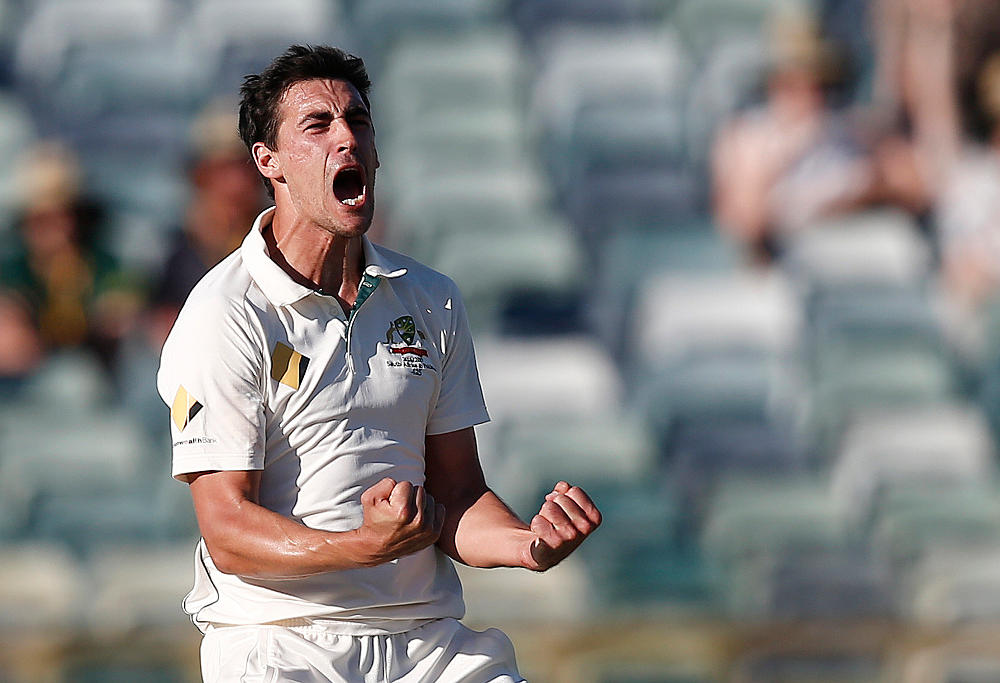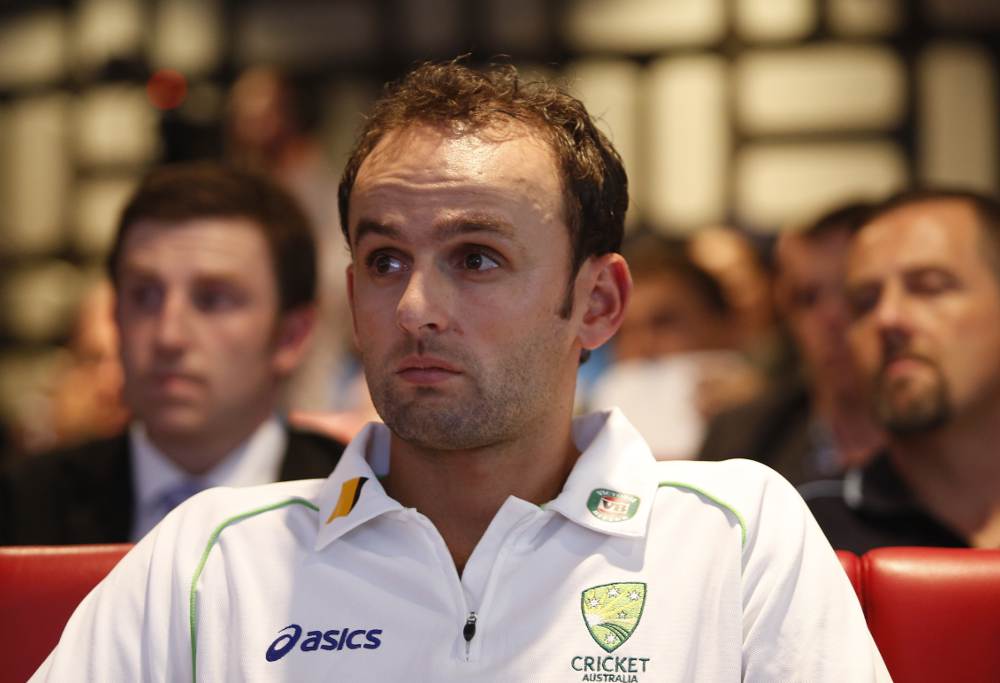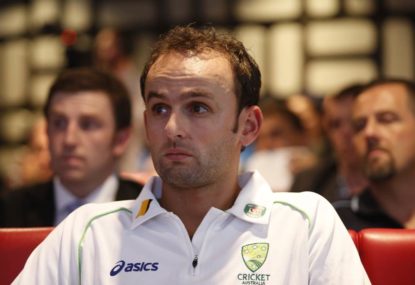Australia should build their attack around pace for the first Test in India next month, playing three specialist quicks, leaving Nathan Lyon on the bench and using Glenn Maxwell as spin support for Steve O’Keefe.
That depends, of course, on the pitch conditions. If the surface is a raging turner then Lyon should come into the team at the expense of third paceman Jackson Bird, with Maxwell’s spot at six going either to a specialist batsman or to all-rounder Hilton Cartwright, who can offer an extra seam bowling option.
The Australian squad for India will be announced soon, with the group to head to Dubai at the start of February for a two-week training camp before flying to India for one tour game. Last time they toured India, Australia took a 17-man squad so this would be my group, topped by my starting XI for the first Test in Pune starting on February 23.
1. David Warner
2. Matt Renshaw
3. Shaun Marsh
4. Steve Smith (c)
5. Peter Handscomb
6. Glenn Maxwell
7. Peter Nevill (wk)
8. Mitchell Starc
9. Steve O’Keefe
10. Josh Hazlewood
11. Jackson Bird
12. Nathan Lyon
13. Usman Khawaja
14. Ashton Agar
15. Hilton Cartwright
16. Chadd Sayers
17. Ashton Turner
O’Keefe should be Australia’s first-choice spinner in India for the sake of the tourists’ trump cards Mitchell Starc and Josh Hazlewood. It is that pace pair, not Australia’s spinners, who pose the biggest threat to the Indian batsmen.
Starc showed in Sri Lanka five months ago what a force he can be in Asian conditions, hoarding 24 wickets in three Tests. With his searing pace, lethal yorkers and skill to swing the new and old ball, Starc is able to largely take the pitch out of the equation, remaining effective on surfaces which would render many quicks impotent.

Hazlewood, meanwhile, is arguably the most in-form paceman in Test cricket worldwide. In six Tests this summer, Hazlewood grabbed 32 wickets at an average of 21 and routinely removed the key opposition batsmen.
He bowled well, without much fortune, in his first series in Asia last year. Hazlewood was poorly used in that series in Sri Lanka, with captain Steve Smith making the mistake of repeatedly handing the new ball to Lyon instead of the tall quick.
The towering seamer is similar in style to star England paceman Stuart Broad, who was his side’s best bowler in their recent five-Test series in India. Hazlewood has also drawn comparisons, from the very start of his career, with Glenn McGrath, the legendary Australian quick whose Test record in India was astonishingly good.
To start with, I would bank on either tall paceman Jackson Bird or short swing bowler Chadd Sayers to be more effective than Lyon. The veteran off-spinner looked set to be dropped for O’Keefe after bowling horribly in the opening Test of this summer against South Africa. Only a calf injury to O’Keefe seemed to save Lyon.
He has just completed by far the worst home summer of his Test career, averaging 50 with the ball and conceding 3.62 runs per over, well above his career figure of 3.15 before this summer.
If Lyon is conceding 3.62 rpo on his preferred home decks against South Africa and Pakistan, it’s hard to see how he’ll keep his economy rate below four in India on less suitable pitches against a more dominant batting line-up.
Australia cannot afford for their spinners to be expensive in India. It would ease any pressure built by Starc and Hazlewood. It would also mean India’s batsmen could play defensively against Australia’s gun pace duo safe in the knowledge they will easily up the ante against loose spin bowling.
There has been a lot of talk in the media and among Australian fans about the need to pick “attacking” spinners in India. Champion leg-spinner Shane Warne has been pushing for Mitchell Swepson, Test legend Steve Waugh has backed Fawad Ahmed and former Test skipper Michael Clarke has pushed for Adam Zampa.
Australia’s problem is they don’t have a decent attacking spinner. Swepson is extremely green, Fawad can’t even get a game for Victoria, and Zampa is a limited-overs specialist with an awful first-class career record.
When it comes to spinners, “attacking” also translates as “expensive”, except for geniuses like Warne, Muttiah Muralitharan and Ravi Ashwin. Australia’s best attacking options in India, by far, are Starc and Hazlewood. The bowling unit in India must be built around that pair, not around Australia’s spinners.
The tweakers should not be used as Australia’s strike bowlers. Their role should be to keep things as tight as possible, chip in with wickets when conditions suit, and make things easier for the quicks. O’Keefe is perfectly suited to such a role. His economy rate of 2.52 runs per over in first-class cricket is extraordinary – equal to McGrath’s career figure.
O’Keefe’s rare level of control was evident in the third Test against Pakistan. On a run-filled pitch on which Yasir Shah went at almost 6 rpo and Lyon at 3.6, O’Keefe was very frugal, conceding just 2.8 rpo.
O’Keefe manages to be economical without bowling defensively. Unlike cautious left-arm spinners of the past like England’s Ashley Giles and South Africa’s Paul Harris, who just tried to dart the ball in at the batsmen’s legs, O’Keefe utilises enticing flight and maintains an attacking line, particularly to right-handers.
He also has one big advantage over Lyon in regards to bowling in Asia. O’Keefe bowls with more sidespin than Lyon, whose reliance on overspin and generating bounce has made him ineffective in the sub-continent.
On Asian pitches, local spinners concentrate on side spin because it makes them more unpredictable. Depending on whether the ball lands on the seam or the smooth part of the ball, it will either grip and turn or skid on straight. It is this natural variation which earns them wickets, and which has befuddled visiting Australian batsmen for decades.
Spinners like Lyon who bowl with heavy overspin tend to catch the seam far more often and so it is far easier to predict how their deliveries will behave. This is a key reason why Lyon has struggled in his 11 Tests in Asia, averaging 43.

Last year he arrived in Sri Lanka in career-best form, coming off a prolific 18 months in Test cricket. But Lyon’s Australian style of spin again proved less effective as he was comprehensively outbowled by all of Sri Lanka’s spinners.
It is a worrying sign that Lyon, brimming with confidence, laboured against an ordinary, inexperienced Sri Lankan batting line-up. Now he is clearly lacking in confidence and will face a rampant Indian batting line-up which made 550, on average, in the first innings during their recent five-Test series against England.
Pakistan captain Misbah-ul-Haq predicted Lyon’s reliance on over spin would see him struggle in India.
“When the bowlers from here (Australia) go to Asia, they find it difficult to utilise these sort of turning tracks, because there, under-cutter bowlers who bowl quicker are effective,” he told the media.
“Bowlers who bowl overspin and bowl slower normally get thrashed.”
Lyon should not be an automatic choice for the first Test in India.































































































